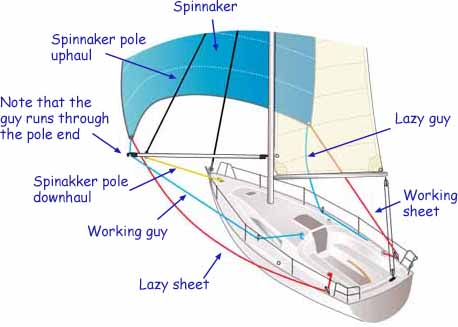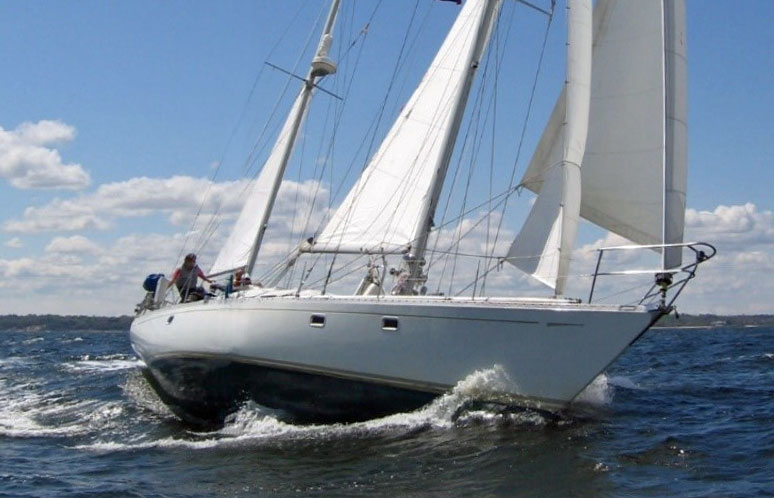Running Rigging & The Quest for Performance
In a Nutshell...
Beyond the basics of hauling and trimming, running rigging is the direct interface for optimising your boat's performance. For the experienced sailor, understanding the nuanced role of halyard tension, sheet lead positions, and the material science behind modern ropes is critical. Optimising these elements can be the difference between a good sail and a race-winning performance, ensuring not only better speed but also greater control and longevity of your sails and gear.
Table of Contents
Halyards: Beyond the Hoist, Into Sail Shape
An experienced sailor knows a halyard isn't just for hoisting sails; it's a primary control for sail shape, particularly for the draft and depth of the sail's luff. As a performance cruising sailor, I want to get the best out of my boat—I've seen firsthand how a small adjustment to halyard tension can dramatically alter a sail's performance.
- Upwind Performance: In moderate to heavy wind, tensioning the halyard (especially with a low-stretch line like Dyneema) pulls the draft forward, creating a flatter sail and a more open leech. This reduces heeling and weather helm, allowing the boat to point higher.
- Downwind & Light Air: Easing the halyard tension slightly allows the draft to move aft and the luff to become fuller. This increases power, which is essential for sailing in light conditions or for downwind speed.
- Material Selection: The choice of halyard material is paramount. A high-modulus line (e.g., Dyneema, Vectran) is crucial for performance-oriented sailing because its minimal stretch ensures that halyard tension, and therefore sail shape, remains constant under load.
Sheets: The Art & Science of Sail Trim
The ability to feel and respond to changes in wind pressure through the sheets is a hallmark of an experienced sailor. Proper sheet trim is a dynamic process, not a static setting.
- Mainsheet & Traveller: The mainsheet controls the sail's twist and the boom's angle, while the traveller controls the boom's position relative to the boat's centerline. A common mistake is to over-sheet the main. For a flatter sail and reduced heel, you should ease the mainsheet and bring the traveller up.
- Jib & Genoa Sheet Leads: The sheeting angle is defined by where the sheet runs through the block on the deck. Moving the sheet lead aft tightens the foot and opens the top of the sail, which is useful for upwind sailing in light air. Moving it forward flattens the top of the sail and powers up the foot, a common setting for more breeze.
- Chafe & Wear: On my own boat—'Alacazam', a self-built wood-epoxy cutter—I regularly inspect the points where sheets run through blocks or over coamings. Chafe is the silent killer of rope, and a professional sailor learns to identify these weak spots before they become a problem, often adding sacrificial covers to extend the line's life.
Guys: Spinnaker Sailing
 Spinnaker running rigging setup
Spinnaker running rigging setupWhile often associated with spinnakers, a guy is a line with a specific purpose that requires careful handling. With a spinnaker, the guy is a vital control for the pole's position.
- Controlling the Spinnaker Pole: The guy pulls the spinnaker pole aft and away from the mast. The 'lazy' sheet becomes the 'guy' and vice-versa with each gybe. The ability to manage this transition smoothly is what separates a good spinnaker crew from a great one.
- Downwind Performance: The guy, in combination with the foreguy and afterguy, allows the pole to be precisely positioned to square the sail to the wind on a deep run or to feather it on a reach.
- Load & Safety: The loads on a spinnaker guy can be immense, especially in a gust. Using a robust, low-stretch line and ensuring all hardware (blocks, shackles) is rated correctly is a critical safety consideration.
A Quick Comparison: Performance Application
| Component | Performance Function | Material Recommendation |
|---|---|---|
| Halyard | Tension control for draft position | Low-stretch Dyneema or Vectran |
| Sheet | Dynamic trim for sail shape & twist | Blended lines (Polyester/Technora) for grip |
| Guy | Precision pole position & control | Dyneema with a tough cover for chafe resistance |
For the full low-down on sailboat rigging, take a look at The A-Z of Sailboat Rigging: A Guide to Standing & Running Rigging.
Article written by Dick McClary, RYA Yachtmaster & Yachting Journalists Association (YJA) member.
Frequently Asked Questions (FAQs)
What is the best way to rig a 2:1 main halyard?
What is the best way to rig a 2:1 main halyard?
A 2:1 purchase on the main halyard reduces the load on the winch, making it easier to hoist and fine-tune tension. It's typically rigged with a block at the masthead and the line dead-ending on the mast or a mast tang, before running through a block on the head of the sail and back down to the cockpit.
How do I choose between a low-stretch and high-stretch rope?
How do I choose between a low-stretch and high-stretch rope?
For running rigging that controls sail shape (halyards, sheets), low-stretch lines (Dyneema, Vectran) are preferred to maintain consistent sail trim. High-stretch lines (Polyester) are often used for control lines where a little give is desirable.
What is the purpose of a barber hauler?
What is the purpose of a barber hauler?
A barber hauler is a control line used to adjust the sheeting angle of a headsail or spinnaker outboard. It's an advanced trim tool that can be used to open up the leech for better performance in certain wind conditions.
How do I manage chafe on my running rigging?
How do I manage chafe on my running rigging?
Regularly inspect all lines, especially where they run through blocks, fairleads, or clutches. Replace worn lines proactively, and consider adding chafe guards or protective covers to high-wear areas.
Sources
- The RYA Manual of Seamanship, by Tom Cunliffe. https://www.rya.org.uk/
- Performance Sailing & Racing, by Steve Sleight. https://www.google.com/search?q=Performance+Sailing+%26+Racing+Steve+Sleight
- Sail Power: The Complete Guide to Sail Handling and Trim, by Wallace Ross. https://www.google.com/search?q=Sail+Power+Wallace+Ross
Recent Articles
-
Modern Boat Electronics and the Latest Marine Instruments
Dec 20, 25 05:27 PM
Should sailboat instruments be linked to the latest boat electronics as a fully integrated system, or is it best to leave them as independent units? -
Hans Christian 43: Classic Bluewater Cruiser & Liveaboard Sailboat
Dec 10, 25 04:37 AM
Explore the Hans Christian 43: a legendary heavy-displacement, long-keel sailboat. Read our in-depth review of its specs, design ratios, and suitability for offshore cruising and living aboard. -
Planning Your Sailboat Liveaboard Lifestyle: An Ocean Sailor's Guide
Dec 06, 25 05:18 AM
Seasoned sailors share their methodical risk analysis for planning a secure Sailboat Liveaboard Lifestyle, covering financial, property, and relationship risks.













